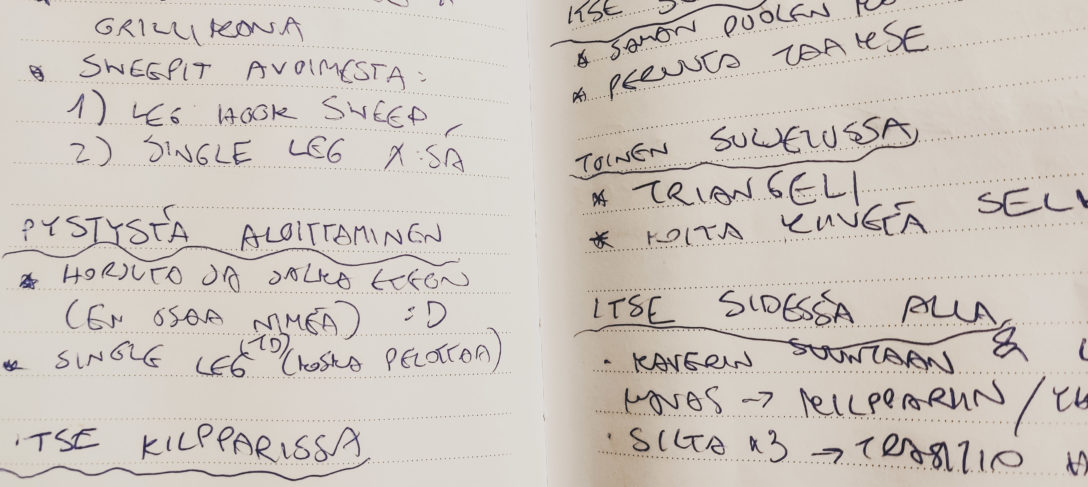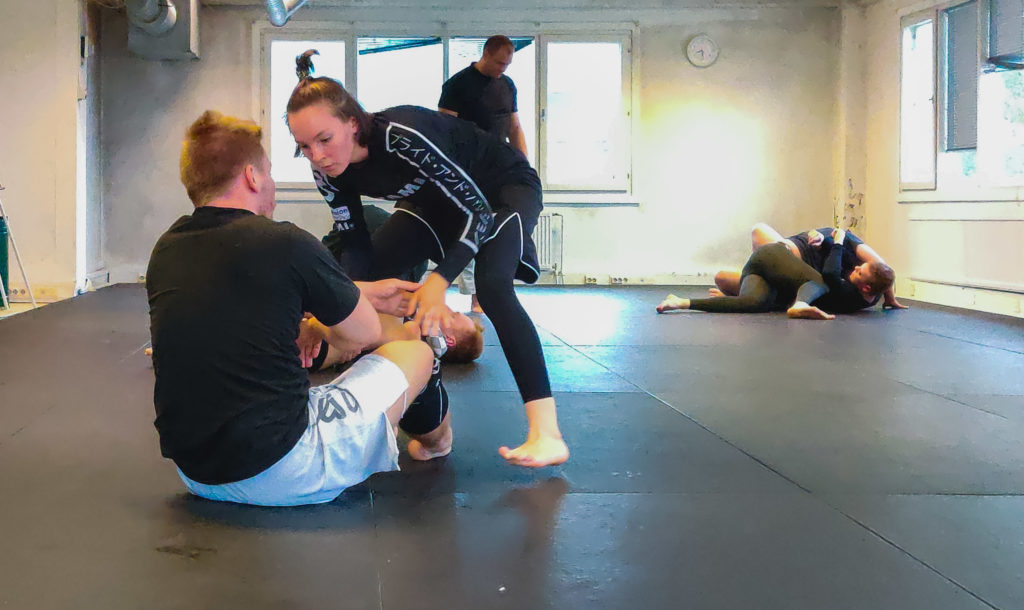There’s still a bit of a pandemic going round, so my sparring days are pretty limited at the moment. But during the brief respite Finnish contamination statistics offered during the summer, I managed to roll with a game plan. Or a limited repertoire of techniques, depending on how you look at it.
Techniques in Brazilian jiu-jitsu run into several hundreds and the total number of variations probably lies in the thousands. Outside of competitions, my natural curiosity has led me to approach sparring with trying a bit of whatever, then falling back on the few trusted techniques I know by heart when I get too frustrated. As an exercise for widening my pool of reliable techniques I could pull off without freezing first, I picked two techniques from every basic BJJ position. When sparring, I attempted to use only those techniques for two weeks. Here are the positions I picked and how things worked out.
Both standing
- A single leg take-down, because I’m scared of doing them (and breaking my neck). Maybe, maybe managed one at some point – and that was after following an opponent who was trying to stand back up.
- Osotogari, or “that one judo throw Jyri taught me when he realised I know fuck-all about stand-up techniques”. This one used to work against some training partners, but I’ve either lost my touch or they have wisened up. I only got white belts newer than me in it a couple of times.
Me in open guard
- Leg hook sweep. I simply tried to control at least one ankle and my partner’s opposite hip – if I didn’t sweep them, I tried to wrap my arm round their other ankle as well. Not overthinking the technique was pretty liberating, and I did get some sweeps done.
- Single leg x sweep. I don’t know why I picked this, probably because it’s one I’ve actually tried to learn. Didn’t succeed with it even once. After my experiment had ended, we drilled this sweep in class and I realised I’d forgotten to actually wrap my leg round my opponent’s hip. Instead, I’d just pushed it against the front of their hip. No wonder.
- In practice, I just ended trying to retain some form of guard quite a lot.
Passing open guard
- Good old knee slides. I feel a bit guilty using them as they can sometimes work more because of my weight, not technique. However, I’ve learned compiling them with some mount transitions so got to fine-tune that as well.
- Toreando pass. Typically I ended up falling over my own feet, which I’m prone to do at even your normal guard passing drills. Sometimes I did get to pass, which was cool.
Me in mount
- Arm triangle. I forgot to keep my own head close to the head of my partner, so no submissions were happening. A black belt took pity of me and pointed this shortcoming out. Then he coached me through performing the technique correctly. At least I remember that from now on.
- The one x-choke that begins with putting your knuckle on the ground. I don’t know the technique’s actual name and Jyri couldn’t remember teaching it to us from my explanation. I hit this a couple of times on people newer than me.
- I remember getting one armbar from mount after running out of other ideas. This never happens so it was worth mentioning.
Me being mounted (this still happens way too often)
- Bridge-and-sweep. Works sometimes, needs more finesse.
- Transition into bottom half guard. Was not a foolproof success. I managed it better when my partner wasn’t expecting it or I managed to shake them round a bit first.
Me in turtle
- Blocking the opponent with a leg and falling on my butt, pulling the opponent into closed guard. It worked better than the only turtle escape I had for the first 4 months of BJJ, scooting forwards and having my back taken.
- A personal favourite: trapping the opponent’s arm gently and sweeping them underneath my side control. Some success, sometimes I didn’t get the momentum right. With a white belt stronger than me we ended up flipping round in painful slow motion, teetering on the edge of will-this-work-or-not. He chuckled when the whole mess finally ended with him underneath me.
Opponent in turtle
- Seatbelt & tried to hook the opponent’s leg and take their back. I very rarely get to take the back of anyone (unless they are much smaller than me and/or very new). I doubt I got the technique to work very successfully. A couple of times I bruteforced in the wrong direction and achieved side control in a very dishonourable manner.
- Seatbelt & flipping round the opponent’s shoulder. I’m not very good at this either, don’t really have the nerve to build the momentum required. I’m definitely better at being in turtle than managing someone in turtle.
Me in closed guard (or, the one big people aren’t naturally great at)
- Didn’t get a single one but tried valiantly. An upper belt visiting from Oulu took my back thrice when I tried to armbar him. Then he started to explain that I might do a bit better if I used both my hands: one to control the arm I’m going to try to armbar, the other to push against his head when I transitioned away from my closed guard. I was again glad for the notes.
- Triangle. In June, me and my training partner accidentally taught each other the right side to close a tringle choke. Did I choke anyone during my experiment: lol no. I have memories of seeing more opportunities to try triangles and attempting to get my legs round the shoulders of various training partners, but never got it to the end. One day.
Opponent in closed guard
- Reversing out. I haven’t a clue if this is a real technique, but I sometimes wiggle my hips around a bit and manage to move backwards in a way that results with me opening the opponent’s leg. I might just be bafflement or exhaustion on my partner’s part. Still, I needed two ideas for every position so this is what I tried occasionally and got out.
- Trap opposite arm and stand up. Very route-one, I think we first learned about it on the beginner’s class. I’ve once got an opponent’s legs open with this in a competition so it often works, in this experiment as well.
Opponent in side control
- Transition to mount. Americanas and kimuras come pretty naturally to me already but transitions don’t – so I spent my time in side control trying to change to another position. Some mount transitions did happen. Occasionally I still suffered from my common grievance: trapped leg.
- Transition to back control. I have been bad at recognising opportunities to take someone’s back so I used some of my side control positions to turn my opponent’s upper body away from me, then taking their back. Several attempts worked, although again with much smaller opponents.
Me in side control
- Bridging away from the opponent and

I walk my rash guard. transition to turtle. Sakke showed us this move in one class and it changed my life – the amount of agonising minutes spent under an opponent’s side control has diminished dramatically. It worked pretty well in sparring too, as long as I remembered to move my hips far away from my training partner.
- Three bridges and transition to half guard. Pretty efficient, but like most bridge manouvres, required surprising a sparring partner to an extent.
My back taken
- Head to mat and wriggling out of the grip. Another beginner’s class favourite. I know the best back escape is not giving your back away. But sometimes that happens with me, and luckily I’m often persistent enough to get this escape to work.
- Sliding out downwards. This working required my opponent making a mistake, but was still worth having in my arsenal.
Me in back control (doesn’t happen often)
- RNC. Nope, didn’t happen. I feel I lacked the automatic responses to ensure proper grips, sparring partners always managed to save their neck.
- Cross collar choke. Again saved by the black belt: Joonas realised what I was trying to achieve (poorly) and talked me through pushing backwards with one hand and downwards with another. Needs more work.
What we have learned
If you made it down here, congratulations on your persistence. I rarely get too technical when I write about my BJJ antics, but this experiment I wanted to log for posterity’s sake. If I learned anything from this I realised the following:
- It’s never a bad idea just to drill something a bit more before trying it out in the wild.
- Upper belts can be very sweet and helpful when they see you Doing It Wrong.
- Having only two options from each position probably did make my reaction times a bit better. I spent less time umming and ahhing which move to use.
- It’s not that satisfying to keep doing the stuff you know the best. Sure, I could stick to the americana-armbar-kimura-submission triad attempts in side control until either me or my opponent slips up. But I know those already, unlike developing working transitions into mount of back control. If I’m not competing, I’ll try to use my rolls to develop stuff, not holding on to some illusion of having to win.
- I know more techniques than I think. Of course, I’ve seen and forgotten probably 200 by this point, but having at least working knowledge of a dozen of them feels good compared to the S who had to have their hand held through shrimping and bridging in 2018.
- I still want to get better at so much stuff. But as you need to be good at something before you can be good at more things, I’ll probably think about rolling more purposefully when that is possible again.
So, COVID-19 cases are on a slight increase where I live. Currently purposeful rolling is off the table, as a training partner and me have teamed up to attend classes together 2 metres away from everyone else, not switching partners for the foreseeable future. We have rolled a bit too, but for now my most important goal is not to cause her or myself the sort of injury that would keep us off the mat. This year continues to be very peculiar.



I enjoy reading your detailed posts! Your movement vocabulary has obviously grown and you’re great at articulating what you’re doing and why. Thanks for sharing your experiments and your lessons. Cheers from Toronto during this ongoing peculiar year!
2020 and COVID are such a mess. It’s good that you can approach your training in a structured way, at least, you’ll be very good at THIS when this whole thing is over.
I took the time to focus a lot on my no-gi stand-up game, really shows that I’m good at only one specific thing, but it sure does work 🙂
Good luck!